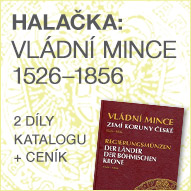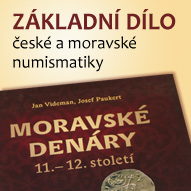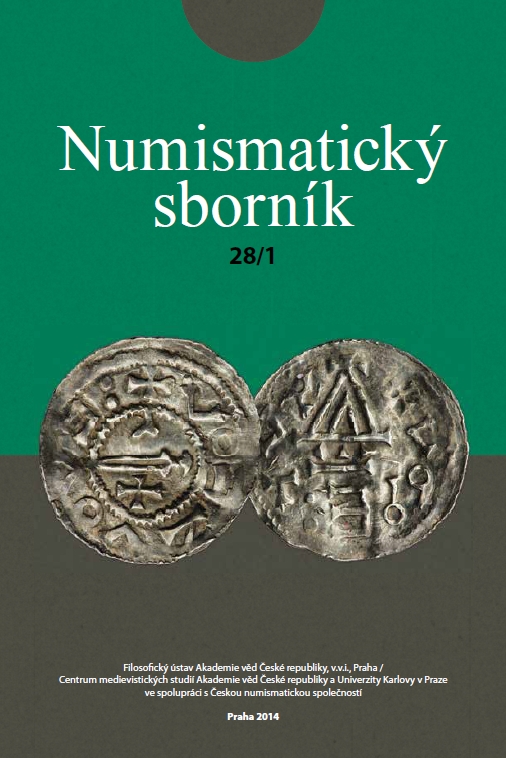Novinky ze Zpravodaje
Vyberte si téma, které Vás zajímá a objednejte pravidelný e-mail s novinkami ze Zpravodaje.



Numismatický sborník 28, 2014/1
První číslo 28. ročníku Numismatického sborníku přináší sedm odborných studií až na jednu výjimku z oblasti středověké numismatiky. Blok nálezových zpráv zahrnuje 18 článků. Numismatický sborník je nepostradatelnou pomůckou pro všechny, kteří se vážně zabývají historií a numismatikou.
Numismatický sborník

Numismatický sborník 28/1 si můžete objednat na info@nume.cz. Cena prvního svazku je 180,- Kč + poštovné a balné 70,- Kč. Svazek 28/2, zaměřený výhradně na keltskou numismatiku, vyjde koncem roku 2014 nebo na počátku roku 2015.
Obsah sešitu 28/1
Jiří Lukas
Denáry mečového typu (III). Mladší varianty denárů typu meč-kaplice (C 50–52, 56–58)
Deniers of the sword type (III). Later varieties of deniers of the sword-chapel type (C 50–52, 56–58). 3–41
Kateřina Blažková – Vlastimil Novák – Kamil Smíšek – Zdeněk Šámal
Zlomek sámánovské mince objevený na hradišti Dřevíč (okr. Rakovník) v kontextu raně středověkých českých a moravsko-slezských nálezů islámského stříbra
Fragment of the Samanid coin found at the Dřevíč hill fort (Rakovník district) in context of early medieval Bohemian and Moravian-Silesian finds of Islamic silver. 43–56
Jiří Lukas
Nálezy denárů z 11. a 12. století objevené pomocí detektorů kovů (I)
Deniers of the 11th and 12th century found with use of metal detectors (I). 57–70
Robert Kool – Borys Paszkiewicz – Edna J. Stern
Neznámý český denár s obrazem sv. Kryštofa z Montmusard, ‘Akko (Izrael)
An Unknown Bohemian Saint Christopher Penny from Montmusard, Acre (Israel). 71–81
Jan T. Štefan
K české části nálezu Fuchsenhof (1997)
Contribution to the Bohemian part of the Fuchsenhof hoard (1997). 83–87
Petr Schneider
Dochovaná část brakteátového depotu ze Smržova u Českého Dubu (okr. Liberec)
Preserved part of the bracteate hoard from Smržov near Český Dub (Liberec district). 89–94
Daniel Haas Kianička
Nálezy Medailí?
Finds of medals? 95–100
Nálezy mincí na území České republiky
Coin Finds in the territory of the Czech Republic
Július Fröhlich
Niekoľko zaujímavých keltských mincí z oppida Hradiště u Stradonic
Some interesting Celtic coins from the oppidum of Hradiště near Stradonice. 101–105
Jiří Militký
Doplněk k nálezu římských zlatých mincí z Dobronic (okr. Tábor) z roku 1878
Addition to the find of gold Roman coins from Dobronice (Tábor district) found in 1878. 106–108
Vojtěch Brádle – Jiří Militký
„Znovuobjevený“ aureus Alexandra Severa z Černilova (okr. Hradec Králové)
A ʻre-discoveredʼ aureus of Alexander Severus from Černilov (Hradec Králové district). 108–110
Filip Krásný – Jiří Militký
Nález východořímského solidu Lea I. z Loukovce (okr. Mladá Boleslav)
An Eastern Roman solidus struck under Leo I found in Loukovec (Mladá Boleslav district). 111–113
Jiří Lukas
Nález denáru – imitativní ražby u obce Radovesnice II (okr. Kolín)
An imitative denier issue found in the outskirts of Radovesnice II (central Bohemia, Kolín district). 113–117
Jiří Lukas
Nález denáru Boleslava II. C 78 v předpolí hradiště Hanín (k.ú. Kolín, Středočeský kraj)
The denier of the C 78 type struck under Boleslaus II found in the foreland of the Hanín hill fort (the Kolín land register, central Bohemia). 117–122
Jiří Lukas
Nález denáru knížete Oldřicha C 296 v Hořanech (okr. Kutná Hora) z roku 1903
A denier struck under the Duke Oldřich (C 296) found in Hořany (Kutná Hora district) in 1903. 122–124
Jiří Lukas
Depot denárů z roku 1903 ve Vraclavi (okr. Ústí nad Orlicí)
Hoard of deniers found in Vraclav (Ústí nad Orlicí district) in 1903. 124–127
Vojtěch Brádle
Starší nález denáru Oty I. Sličného u Olomouce?
A denier struck under Otto I the Handsome found formerly near Olomouc? 127–128
Petr Schneider – Tomáš Smělý
Nález brakteátů z katastru obce Opolany (okr. Nymburk)
Bracteates found in the forest near Opolany (Nymburk district). 129–131
Petr Schneider – Tomáš Smělý – Lukáš Císařovský
Nález brakteátového svitku ze Smrkovic (okr. Písek)
A bracteate pile found in Smrkovice (Písek district). 131–133
Jiří Militký – Martin Vyšohlíd
Tři středověké „žetony“ objevené při archeologickém výzkumu v areálu bývalých kasáren Jiřího z Poděbrad na náměstí Republiky v Praze 1-Novém Městě
Three medieval ʻjetonsʼ found via archaeological excavations in the area of the former barracks named after George of Poděbrady in the Republic Sq., Prague 1-New Town. 133–136
Jan Cihlář – Lukáš Richtera
Nález pražských grošů Václava II. a Jana Lucemburského u zaniklé středověké vsi Komorsko, k. ú. Čenkov (okr. Příbram)
Prague grossi struck under Wenceslas II and John of Luxembourg found near the vanished medieval village of Komorsko, the Čenkov land register (Příbram district). 137–141
Martin Čechura – Jiří Militký
Nález mincí u kostela sv. Ducha ve Všerubech (okr. Plzeň-sever)
Coins found near the St. Spirit Church in Všeruby (Pilsen-North distict). 142–143
Ondřej Černohorský – David Vích
Tři drobné hromadné nálezy pražských grošů ze Svitavska
Three small group finds of the Prague grossi discovered in the Svitavy region. 144–148
Ladislav Nekvapil
Nález drobných kiprových mincí z Poličky (okr. Svitavy). Předběžná zpráva o stavu zpracování depotu
Small kipper coins found in Polička (Svitavy district). A preliminary report on the hoard processing. 148–154
Miroslav Hus
Nálezová kolekce mincí objevená při archeologickém výzkumu v Kralovicích (okr. Plzeň-sever)
Coins found during the archaeological excavations in Kralovice (Pilsen-North district). 154–161
Vojtěch Brádle
Nález mince Ludvíka XIV. ze Lhoty u Pecky (okr. Jičín)?
A coin struck under Louis XIV found in Lhota near Pecka (Jičín district)? 161–163
Abstrakty a klíčová slova
Abstracts and Key words
Deniers of the sword type (III). Later varieties of deniers of the sword-chapel type
(C 50–52, 56–58).
The latest group of deniers of the so-called sword type (Cach 1970, nos. 50–52, 56–58) is presented and described in detail in this study, with analysis of interconnection of the particular dies included. Appearance of these deniers in coin hoards, their metrology and die engraving fabric show that the group of the described varieties of the deniers of the sword type was struck in the first half of the 990s.
early medieval times, Bohemia, denier
Fragment of the Samanid coin found at the Dřevíč hill fort (Rakovník district) in context
of early medieval Bohemian and Moravian-Silesian finds of Islamic silver.
In 2013, a fragment of the Samanid dirham dated back to the beginning of the second half of the 10th century was found after ploughing in the territory of the early medieval hill fort in Dřevíč (Rakovník district). Unfortunately, the fragment bears no relevant information (mint, date, caliph´s name, ruler´s name). Composition of legends, calligraphy and character of letters point at the Samanid provenance of the coin fragment. Regular and massive lettering, as well as grainy character of metal with its decreasing quality, refer to the breaking Samanid period beginning with the rule of Mansur I b. Nuh (AH 350–365/ AD 961–976). In that way, it is possible to speculate successfully about dating of the original coin to the third quarter of the 10th century. In real, the coin/ fragment was buried at the mentioned locality sometime around the break of the 10th and 11th century. It was evidently not a part of any hacksilver hoard, it was probably accidentally lost at the locality. History of the site is attached. There are several hoards of the 10th–early 11th centuries containing silver used as weighed metal registered in the territory of Bohemia, Moravia and Silesia. The Bohemian hoards differ by their composition from those ones of Moravia and Silesia. In Bohemia, very few fragments of Islamic coins appeared in hoards or as single finds. It is one of the typical features for the specific Bohemian silver circulation of that period. Besides pure coin hoards, also untypical hacksilver hoards – better “hoards of silver circulated by weight” (i.e. cumulative hoards of coins and jewelry related to the noble milieu) are found there. Islamic fragments were present in all Moravian and Silesian hoards (typical hacksilver hoards) of the mentioned period and their appearance was a result of the ties of this territory with southern segment of the Oder-Vistula trade basin, its southernmost section. Both territories (Bohemia and Moravia-Silesia) accepted practice of weighed metal (hoards mixing coins, their fragments, jewelry, and their fragments), and the situation there was typical by a relatively small amount of silver metal in local circulation. The hoards in Moravia and Silesia represent the peak demand for Islamic silver before start of the local central European coinage. The Islamic element in the hoards shows great territorial and chronological diversity. The Samanid fragments represent largest part in the Islamic section, mostly dated back to the peak period of the silver supply (circa AD 940–950).
Dřevíč, hill fort, Bohemia, Moravia, Silesia, Islamic coin fragments, hacksilver, the 10th–early 11th centuries, the Samanids
Deniers of the 11th and 12th century found with use of metal detectors (I).
Advancing and detailed list of coins of the 11th and 12th century found via activities of amateur metal detectorists in Bohemia in 2006–2013 with special respect to the region of the lower part of the Cidlina River, the broader background of the important Slavonic hill fort in Libice nad Cidlinou. The historical classification and finding characteristics of the Bohemian deniers found there can serve – in connection
with the oldest written sources – as evidence for an extraordinary density of settlement, and also can point at the contemporary level of monetarization of the agricultural society in this region in the 11th and 12th century.
early medieval times, Bohemia, denier
An Unknown Bohemian Saint Christopher Penny from Montmusard, Acre (Israel).
A hitherto unpublished Bohemian penny was unearthed during rescue excavations in ʽAkko’s Crusaderperiod Montmusard quarter. A detailed analysis of the coin’s inscriptions, iconography and weight suggests that it was minted by the Bohemian King Přemysl-Ottokar II in 1248 or later. The coin represents the earliest use of the title of rex Boemorum and a previously unobserved contemporaneous veneration of Saint Christopher in Bohemia. It is an important historical document both of Otokar II’s intentions to create an unified Bohemian state and of the multiple contacts between Bohemia and the Latin East in the thirteenth century.
Přemysl-Ottokar II, coin, Crusader-period, Saint Christopher, ‘Akko, Týn nad Vltavou
Contribution to the Bohemian part of the Fuchsenhof hoard (1997).
Metrological-statistical processing of the most numerous group of the Bohemian bracteates of the Fuchsendorf hoard produced correction of the average weight of that type stated by Cach, confirmation of existence of two weight categories in the hoard (previously mentioned in written sources) and confirmation of weight of the Prague grivna. Many of the described problems will surely require proper solution in the future.
hoard, Fuchsenhof, Bohemia, bracteate, two weight categories
Preserved part of the bracteate hoard from Smržov near Český Dub (Liberec district).
The bracteate hoard found near Smržov in a basalt rock wall called Čertova zeď at the beginning of 1912 used to consist reportedly of more than 300 coins. Only 34 of them have been saved up to date, and they could be attributed to the region of Upper Lusatia. The majority of the preserved coins represent production of the margravian Ascanian mints in Bautzen [Budyšín] and Görlitz [Zhořelec] (32 pieces, type nos. 1–4);
only two typologically different specimens can be attributed to Zittau [Žitava] (type nos. 5–6). The Smržov hoard was buried at the end of the 1270s, or, more likely, at the beginning of the 1280s.
Upper Lusatia, the 13th century, Český Dub, hoard, bracteate
Finds of medals?
Finds of medals in Slovakia are dealt. Their number in archaeologically discovered hoards is really very small. Some 850 numismatic finds are registered in Slovakia in 1968–1994 (Nálezy mincí na Slovensku II–IV) during the so-called thaler period. Only 23 medals were discovered during that time, the majority of them represented by the so-called religious medals. The rest is represented by normal medals. The
article tries to answer the question why so little medals are found in hoards and why the religious medals prevail there.
medals, religious medals, finds, Slovakia
Diskuze k článku
Tento článek nemá žádné komentáře.